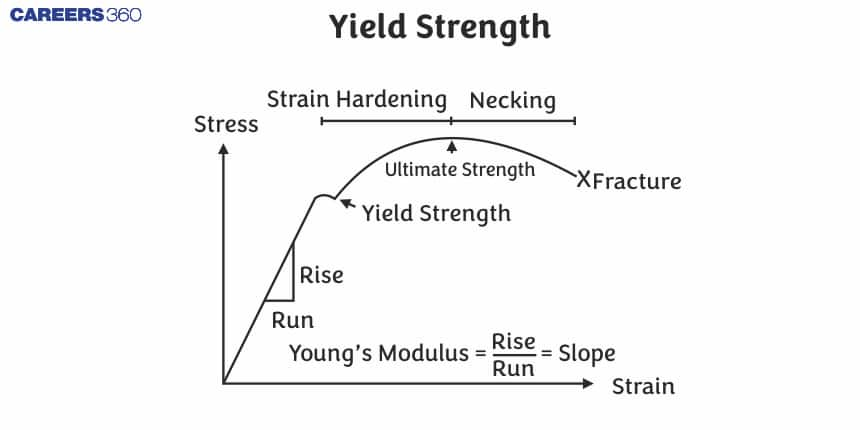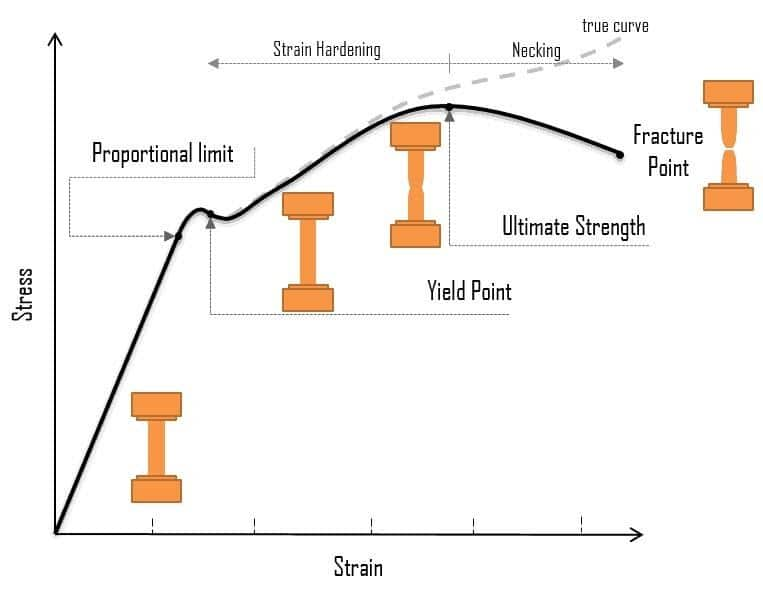Yield Strength - Definition, Example, Formula, FAQs
Introduction
In this article, our focus will be on yield strength, yield stress, yield strength of steel, yield point, the tensile strength of steel, etc.
This Story also Contains
- What is Yield Strength?
- Formula of Yield Strength
- Difference between Yield Strength and Tensile strength

What is Yield Strength?
The yield strength determines whether an object is rigid or pliable. It is the moment at which an object becomes plastic rather than elastic. Yield strength aids in the selection of appropriate construction materials based on the requirements. Because it would have been impossible to mould metals into the unorthodox shapes that we so passionately love, the toys that we so dearly love were constructed from something as pliable as plastic rather than metals.
Also read -
- NCERT Solutions for Class 11 Physics
- NCERT Solutions for Class 12 Physics
- NCERT Solutions for All Subjects
What Does Yield Strength Mean?
Yield strength is a measurement of the greatest stress that a material can withstand without deforming plastically. It is a practical approximation of the elastic limit and is the pressure by which the object shows a definite deformation.
Yield strength is critical in engineering structural design. When constructing a component, for example, it must be able to withstand the force applied during operation and not distort plastically. To put it another way, a material with adequate yield strength should be used.
The yield strength is frequently used to calculate the upper limit of forces that can be applied without producing permanent deformation since it reflects the upper limit of forces that can be applied without generating permanent distortion.
The yield strength of an object determines whether it is difficult to shape or not. The upper yield strength of a material is the point at which it ceases to be elastic and becomes plastic. These upper and lower yield points assist us in determining the best materials for the job. Toys, for example, are typically constructed of plastic since moulding them into the many shapes required to produce them is impractical.
Formula of Yield Strength
The 0.2 per cent offset rule is the most frequent engineering approximation for yield stress. Assume a yield strain of 0.2 per cent and multiply by Young's Modulus for your material to apply this rule. Then the yield strength formula is given by:
![]()
It is also called the yield stress formula. Although the offset method can be used to calculate stress along a single axis, some applications require a formula that can handle two axes. Use the von Mises criteria to solve these issues:
![]()

The Stress-Strain Graph has certain unique characteristics. The following are some of them:
- Proportional limit: Hooke's Law is preserved at the proportional limit of the stress-strain curve. As a result, the stress-to-strain ratio yields a proportionality constant known as Young's modulus. The proportionate limit is the point on the stress-strain graph OA.
- Elastic Limit: This is the point at which the material returns to its original state once the load operating on the body is eliminated. The material does not return to its original state after reaching this limit, resulting in plastic deformation of the material.
- Yield Point: The yield point definition is given as, the point at which a material begins to deform in its current state and, in most cases, turns into plastic. After the point is passed, the object undergoes a permanent distortion in one of two ways. One could be a lower yield point, while the other could be higher.
- Ultimate Stress Point: The ultimate stress point is the point at which the material can endure the most stress before deforming. If the material is pushed past this point, it will fail.
- Breaking or Fracture Point: This is the point at which the material fails
Related Topics Link, |
Yield Stress of Steel
Yield strength is the maximum force that may be given to an object before it changes its shape or structure. The tensile test is used to determine the strength of any material. The material is stressed and pulled aggressively in both directions during this test. A graph, also known as a stress-strain graph, can be generated as a result of this test.
Yield strength of mild steel: 250MPa
Tensile Strength
Tensile strength is the force required to pull an object, such as a structural beam, wire, or rope, to its breaking point. The largest amount of tensile stress that a material can withstand before breaking into little pieces is its tensile or yield strength. The largest stress a material can endure before breaking down is referred to as tensile ultimate strength.
Tensile Strength of Steel
By definition, tensile refers to the ability of steel to be drawn out. Tensile strength is the steel's ability to resist breaking under tensile force. It's used to describe the moment at which steel changes from an elastic to a plastic state. It's commonly expressed in terms of force per area cross-section. The steel rips apart when it is moved away from its stress point.
Also Read:
- NCERT solutions for Class 11 Physics Chapter 11 Thermal Properties of Matter
- NCERT Exemplar Class 11 Physics Solutions Chapter 11 Thermal Properties of Matter
- NCERT notes Class 11 Physics Chapter 11 Thermal Properties of Matter
Tensile Strength of Mild Steel
The maximum amount of stress that any material can bear when pushed or stretched is known as tensile strength. Any tensile strength is put to the test by placing samples of a material with a defined area of cross-section within a tensometer and increasing the force until it breaks.
Few materials break down without deforming, whereas more ductile materials stretch just slightly and shrink when under great stress. Tensile strength is thus quantified in Pascal, pounds per square inch, or Megapascal as a force per unit of area.
Mild steel, on the other hand, is less ductile than other steels because it contains less hardening alloy and carbon. It has a tensile strength of 400MPa, which is relatively low.
Difference between Yield Strength and Tensile strength
Yield strength | Tensile strength |
| 1. The highest stress that a material can sustain while deforming is referred to as yield strength. | 1. The utmost strength that any solid substance may withstand before failing is called ultimate strength. |
| 2. Under any tensile loading, it is the maximum stress that coincides with the yield point in the stress-strain curve. | 2. In the curve below tensile loading, it is referred to as the stress that corresponds to ultimate tensile strength. |
Also check-
- NCERT Exemplar Class 11th Physics Solutions
- NCERT Exemplar Class 12th Physics Solutions
- NCERT Exemplar Solutions for All Subjects
NCERT Physics Notes:
Frequently Asked Questions (FAQs)
The yield strength determines whether an object is rigid or pliable. It is the moment at which an object becomes plastic rather than elastic. Yield strength aids in the selection of appropriate construction materials based on the requirements. Because it would have been impossible to mould metals into the unorthodox shapes that we so passionately love, the toys that we so dearly love were constructed from something as pliable as plastic rather than metals.
The stress at which a solid material that has been stretched begins to flow or change shape permanently is known as the yield point in structural engineering. It is the point on a stress-strain curve that denotes the end of stretchability and the start of plastic behaviour. When a material's stretchability is lower than the yield point, it deforms and after the removal of yield stress point, it regains its original shape.
The Hindi meaning of Yield is उपज.
The minimal shearing or normal stress that must be applied to a solid to cause continuous deformation is the yield value.
The upper yield point is the starting point for plastic deformation. This is because the dislocations in the crystalline structure begin to move. After a while, though, the dislocations become too many and obstruct each other's movement. This is known as strain hardening, and the lower yield point is when strain hardening begins. Plastic deformation occurs beyond the elastic limit, and strains are not fully recovered. When the load is removed, there will be permanent deformation or set. Upper and lower yield points are the terms used to describe these two positions.
A material's proof stress is the maximum amount of stress it can withstand before undergoing a small bit of plastic deformation. Proof stress is defined as the point where the material demonstrates 0.2 percent plastic deformation.
This type of stress is commonly employed in the industrial business to guarantee that a material's elastic limit is not exceeded. That is, a safe load is provided to the object so that it is not stressed to the point of irreversible size or shape change. If a material is allowed to surpass its proof stress, it might permanently distort, leading to failure or fracture.
In the maritime and offshore industries, proof stress is particularly useful. The proof stress of ships and platform legs is crucial in evaluating how much force these structures can withstand before permanently deforming.
Because it is the stress required to make the material yield, proof stress is also known as offset stress.
In material mechanics, strength refers to a material's ability to withstand a load without failure or plastic deformation. The link between external loads applied to a material and the consequent deformation or change in material dimensions is referred to as material strength. These characteristics must be considered when constructing structures and equipment so that the material chosen has sufficient strength to resist applied loads or forces while maintaining its original shape. The ability of a material to endure this imposed stress without failure or plastic deformation is its strength.
By definition, tensile means able to be stretched or dragged out. The resistance of steel to breaking under tensile tension is known as tensile strength. It's usually expressed as force units per cross-sectional area. A piece of steel will split apart once it has been pulled past its tensile stress point.
My strength meaning in Hindi is मेरी शक्ति.